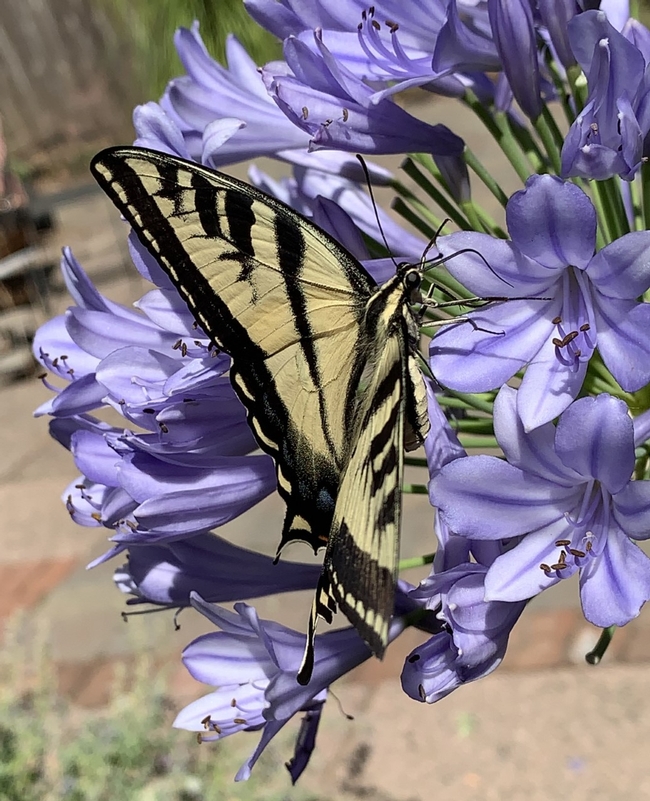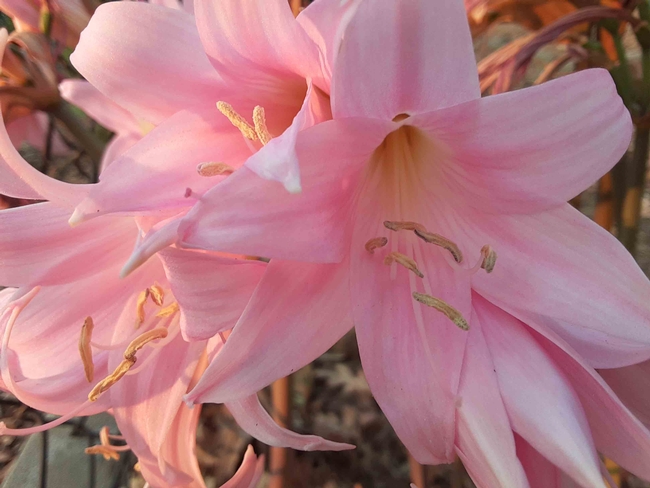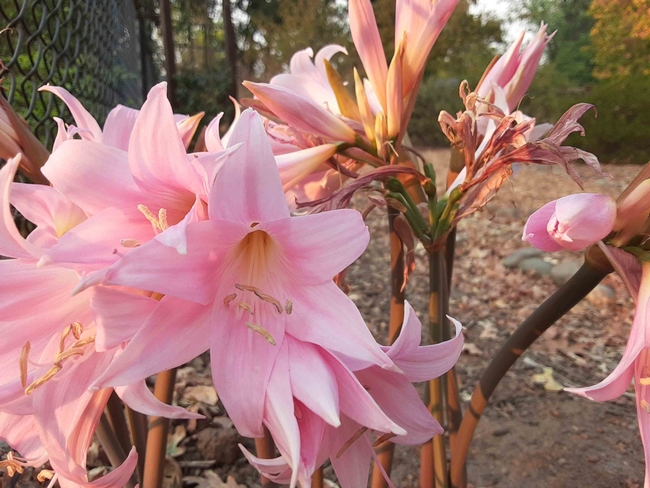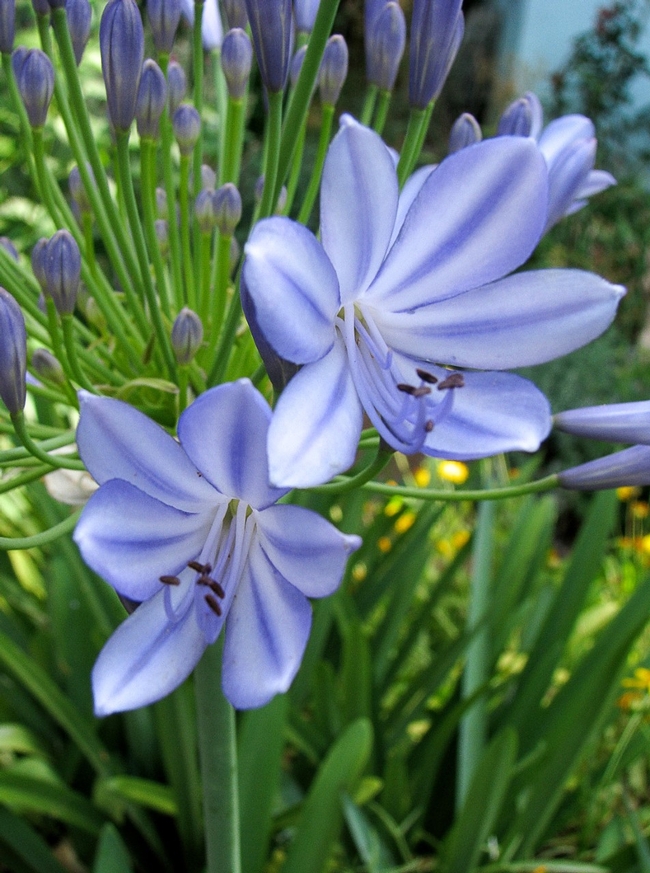Summer is almost over, but it's not too soon to begin planning next summer's garden. Many bulbs flowering in late spring and summer should be planted this fall and winter: they are available at nurseries and online right now.
This article highlights three varieties of lilies which can enliven your garden with a succession of blooms from late spring into early fall when planted together. These lilies are hardy and long-lived, require low to moderate water, and little in the way of maintenance except for deadheading.
Daylily: ‘Stella de Oro'
Often the first to bloom is the Stella de Oro daylily, a variety in the genus Hemerocallis. The name Hemerocallis comes from the Greek words for day (hemera) and beauty (kallos) while ‘Stella de Oro' translates as “star of gold,” combining the Italian word for star with the Spanish word for gold.
‘Stella de Oro' is a deciduous perennial with two- to three-inch scented trumpet-shaped gold-yellow flowers. The foliage is also attractive, forming a dense clump that can function as a ground cover. It requires sun to light shade, low to medium water, and well-drained soil.
It is valued as a compact plant and an early bloomer, reaching a height of just one to two feet with a similar spread. In fact, its ability to rebloom over a long period and its adaptability to a wide range of planting zones and conditions make it perhaps the most popular of the daylilies. It blooms from May through July and sometimes into the fall, flowering most profusely if the spent blossoms are deadheaded. Pinch or cut the flower stem (with ovary) with your thumb and index finger or snap the flower stem off the scape in a quick, downward motion. Deadhead the flowers every third day, finally removing the stems when flowering has finished. Divide by splitting apart in fall or early spring.
‘Stella de Oro', and daylilies in general, are often grown in borders and massed in beds. They are rabbit-proof and deer-resistant. You can cut the flowers to bring inside, add them to salads for a peppery flavor, or leave them to attract butterflies.
Lily of the Nile: ‘Storm Cloud'
The Lily of the Nile genus ‘Agapanthus' derives from the Greek words for love or friendship (agape) and flower (anthos). Agapanthus africanus ‘Storm Cloud' agapanthus is a low-maintenance perennial that can be deciduous or evergreen, depending upon weather conditions. The plants are two to three feet wide with abundant dark green, glossy, strap-shaped leaves. In late June the large umbels (clusters) of deep blue, trumpet-shaped flowers rise far above the foliage on strong three- to four-foot stems and persist through August. Plant in full sun or part shade and provide moderate water. ‘Storm Cloud' can survive a pretty brutal drought, perhaps looking a bit shabby but recovering nicely. It is hardy to 20-25 degrees Fahrenheit. Bees, butterflies, and hummingbirds love it, but deer steer clear. Agapanthus is toxic to humans if ingested.
It is best to divide overcrowded clumps of Agapanthus after flowering, but it can be done any time. Use a very sharp knife to cut a clump into sections, each with roots attached. This is a job that needs to be done only every five years or so.
‘Storm Cloud' looks particularly nice paired with light blue Agapanthus ‘Peter Pan', which blooms seven to ten days earlier.

The Amaryllis genus derives from the Greek word for sparkle; in Classical Greece, “Amaryllis” was a typical name for a country girl or shepherdess. And many will already know that the species name belladonna means “beautiful woman” in Italian. Amaryllis belladonna is an amazing plant that produces clumps of bold, strappy leaves in fall and winter. The foliage dies by early summer and bare stalks emerge in mid-July to August. Each two- to three-foot stalk develops a cluster of up to 12 sweet-smelling, trumpet-shaped four- to six-inch blooms in shades of light rosy pink. Because these bare stalks seem to pop up out of nowhere, the plant is often known as a “naked lady” or “surprise lily.” It is native to South Africa but has naturalized throughout California.

Amaryllis belladonna plants thrive on neglect. Bury the bulbs in groups of three or more in well-drained soil, about six to twelve inches apart so the tops are level with the soil surface. Water from winter rains and an occasional summer irrigation are adequate. Divide Amaryllis lilies only when necessary – that is, when they have developed very large clumps of bulbs and have stopped flowering. The best time to transplant is just after fall bloom, as leaves are starting to emerge. Separate the clumps gently and plant the bulbs into a new spot that has been watered. Bulbs can be transplanted at other times but may not flower for a few years.
An Artist's palette
The trick, of course, is to imagine the possibilities of these lilies together. Flowers, foliage and leaves come and go at different times of the year, adding rhythm and variety to the garden. Perhaps a table would help:
| Plant | Flowers | Leaves | Height | Flower Color |
| Hemerocallis ‘Stella de Oro' |
May – June Sept – Oct |
spring / summer / fall | 1 – 2 feet | golden yellow |
| Agapanthus ‘Peter Pan' |
mid-June to July | spring / summer / fall | 2 feet | light blue |
| Agapanthus ‘Storm Cloud' |
late June to August | spring / summer / fall | 3 – 4 feet | deep blue |
| Amaryllis belladonna |
late July to August | late fall to June | 2 – 3 feet | light pink |

Hemerocallus and Agapanthus have opposite foliage seasons to Amaryllis lilies, and together can be used to fill a garden bed year-round. ‘Stella de Oro' has a very long bloom period (if deadheaded) and short stature, making it suitable to plant in front of taller plants such as Agapanthus. Agapanthus ‘Peter Pan' works very well in front of ‘Storm Cloud.' The foliage of Amaryllis belladonna provides lush greenery throughout the winter and spring, and then in late summer its pink flowers combine beautifully with blue Agapanthus. The fun is in experimenting with different combinations of summer-blooming plants, and in this endeavor, lilies of many varieties have a great deal to offer.
The UC Master Gardeners of Butte County are part of the University of California Cooperative Extension (UCCE) system. To learn more about us and our upcoming events, and for help with gardening in our area, visit our website. If you have a gardening question or problem, email the Hotline at mgbutte@ucanr.edu (preferred) or call (530) 538-7201.
